The wine-growing region of Catalonia is located in the north-east of Spain between the Mediterranean coast and the Pyrenees. It comprises the four provinces of Barcelona, Girona, Lleida and Tarragona and takes its name from the Visigoths (Gotalonia = Gothic land) who arrived in the area in the 6th century AD. The Gothic legal code of 654 was still in use even into the 11th century, although Catalonia became part of the Spanish Marches under Charlemagne at the beginning of the 9th century. In 1137, the territory became part of the Aragonese kingdom through the marriage between Raimund Berengar IV, Count of Barcelona, and the Infanta Petronila of Aragon, but the Catalans maintained their cultural and economic supremacy.
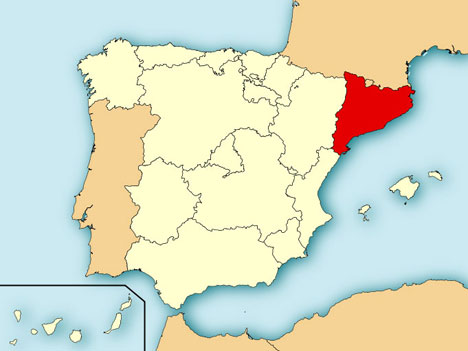 |
| Catalonia is located in the north-east of Spain% close to the French border. (Source: AVC) |
At the end of the 15th century, the unification of Spain began with the union of Aragon and Castile under the rule of the Catholic Monarchs. Between 1640 and 1659 there were revolts in Catalonia, which only came to an end with the Peace of the Pyrenees after the Franco-Spanish War; Spain lost its territories north of the Pyrenees, and thus also part of Catalonia (largely the present-day Roussillon), to France. After the War of the Spanish Succession at the beginning of the 18th century, Catalan self-government ended in 1714, even though the Catalans tried again and again to regain their independence afterwards.
Today, Catalonia is an autonomous community within Spain and has a special degree of independent powers in legislation and administration. Catalan, for example, as one of the oldest Latin-based languages, is formally on an equal footing with Spanish.
Nature: landscape, soil and climate
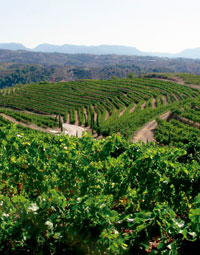 |
| The vines are often several hundred metres above sea level. (Photo: AVC) |
Geographically, Catalonia borders France and Andorra to the north (beyond the Pyrenees), the region of Aragon to the west and the region of Valencia to the southwest; to the southeast lies the Mediterranean Sea. Catalonia thus has both mountain and coastal landscapes and, with the Central Catalan Depression in the west, a wide plateau. Besides the capital Barcelona, the largest cities are Girona, Lleida and Tarragona, each of which gives its name to one of the four provinces.
In the Pyrenees, mountain peaks, high alpine pastures and lonely valleys alternate; there are mountain lakes, fir forests and several important national parks. The Catalan low mountain range is characterised by volcanic landscapes and bizarre rock formations, and the coastal mountains are also rocky. The Montseny mountain range to the north-east of Barcelona is a UNESCO biosphere reserve. Catalonia's coastline is around 580 kilometres long and offers both small bays (in the north) and extensive sandy beaches (in the south). In the southern province of Tarragona, the Ebro, the second longest river on the Iberian Peninsula, flows into the Mediterranean.
In the Mediterranean climate with dry, hot summers and rainy, mild winters, palm trees, agaves, cork oaks and pines thrive, as well as fig, olive and eucalyptus trees. Besides wine, there are numerous other fruits such as cherries, peaches, apricots and citrus fruits, as well as nuts and almonds and wild herbs. The climate is more temperate on the coast than inland. The Catalan soil consists mainly of clay and also contains chalk in the low mountain ranges; on the coast, slate, granite and limestone predominate.
Viticulture: structure and history
After Castile-La Mancha, Catalonia is Spain's second largest wine region with around 60,000 hectares of vineyards. This is divided into eleven protected designations of origin (Denominación de Origen = DO): Alella, Catalunya, Conca de Barberà, Costers del Segre, Empordà-Costa Brava, Montsant, Penedès, Pla del Bages, Priorat (DOCa), Tarragona and Terra Alta. In addition, there are more than 30,000 hectares of vines in the DO Cava, which is a sparkling wine designation for 159 municipalities throughout Spain, but has its origin and geographical focus in Catalonia; more than 90 per cent of Cavas are produced in Catalonia, especially in the Penedès.
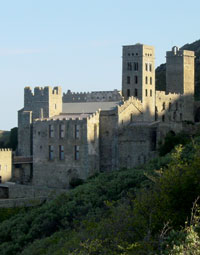 |
| The former Benedictine monastery of Sant Pere de Rodes is located in the province of Girona. (Photo: AVC) |
As early as 200 BC, the Romans were the first to cultivate wine commercially in the area around Tarragona, although the Greeks, the Phoenicians and the Carthaginians had already traded in wine before that. At the end of the 19th century, phylloxera arrived in Catalonia from France and destroyed most of the vineyards. Together with French import duties on Spanish wine, this led to the Catalan vineyard area almost halving in the first half of the 20th century. At the same time, Josép Raventós and Miguel Torres founded the modern age of Catalan viticulture with their respective bodegas.
Especially in the past 30 years, careful grape selection and new vinification techniques have given Catalan wines a quality boost - be it white, red or rosé wines, cavas or the traditional rancios, fortified sweet wines. In addition to the indigenous grape varieties Garnacha (red and white), Tempranillo, Trepat and Monastrell (all red), as well as Macabeo, Parellada and Xarel-Lo (all white), international varieties are increasingly being cultivated. In 2010, Catalan wine production comprised around 165 million bottles of white wine and over 66 million bottles of red wine, as well as almost 245 million bottles of sparkling wine (cava). 43 per cent of the production was exported, with Germany, Great Britain and the USA being the largest consumer countries for Catalan wines. The link between Catalan wine producers and the trade is the Catalan Winegrowers' Association (Associacio Vinicola Catalana = AVC). It represents the economic and social interests of its members, who produce 85 percent of Catalan wines. The president of the AVC is Miguel A. Torres.
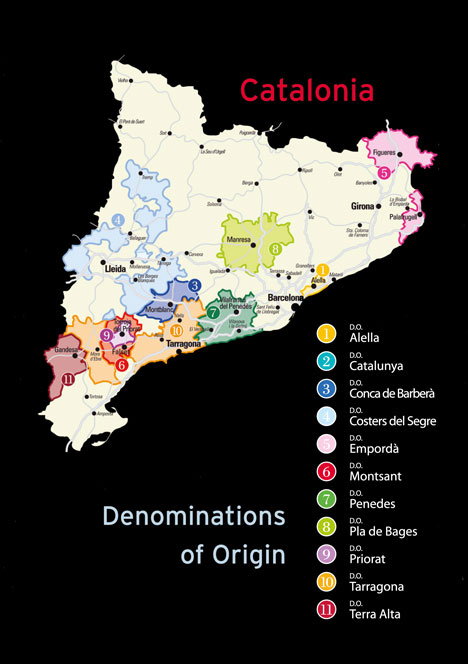 |
| The overarching DO Cava is not limited to Catalonia. (Source: AVC) |
The appellations of origin: 12 profiles
- Location: around the town of the same name on the Mediterranean coast north of Barcelona, between Mataró and Montgat (Barcelona province)
- Status: DO since 1955
- Vineyard area: 560 hectares
- Climate: Mediterranean with hot, dry summers and mild, humid winters
- Soil: high granite content, in the west also clay, lime and occasionally sand; good storage of solar heat and water permeability; known as "Sauló
- Grapevarieties white: Parellada, Pansà Blanca (Xarel-Lo), Moscatel, Macabeo, Chardonnay, Chenin Blanc
- Red grape varieties: Garnacha Tinta, Pansà Rosada, Ull de Llebre (Tempranillo), Cabernet Sauvignon and Pinot Noir
- Wines: mainly dry white wines as well as cava base wines
- Location: Superordinate designation of origin for the wines of about 200 bodegas that are not assigned to any other DO; these are mainly found in two zones: on the one hand in the triangle of cities Lleida - Barcelona - Tarragona, on the other hand north of Girona
- Status: DO since 2001
- Vineyard area: 3,600 hectares
- Grapevarieties white: Chardonnay, Macabeo, Parellada, Xarel-Lo
- Grapevarieties red: Cabernet Sauvignon, Garnacha Tinta, Merlot, Pinot Noir, Syrah, Ull de Llebre (Tempranillo)
- Wines: White, rosé and red wines
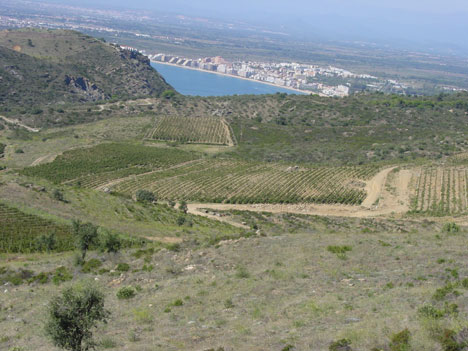 |
| In the province of Girona, the vineyards reach all the way to the coast. (Photo: AVC/Espelt Viticultors) |
- Location: designation for quality sparkling wines not limited to a specific geographical area; applies to 159 municipalities throughout Spain, most of which, however, are in Catalonia
- Status: DO since 1986
- Area under vines: 32,000 hectares (supra-regional)
- Grapevarieties white: Parellada, Xarel-Lo, Macabeo (Viura), Subirat (Malvasia Riojana), Chardonnay
- Grapevarieties red: Monastrell, Garnacha Tinta, Pinot Noir
- Wines: only sparkling wines produced by the bottle fermentation process
- Location: between the DOs Penedès and Tarragona (province of Tarragona)
- Status: DO since 1989
- Vineyard area: 6,000 hectares
- Climate: hot summers, cold winters, high difference between day and night temperatures
- Soil: mainly calcareous and poor in water
- Grapevarieties white: Macabeo, Parellada, Chardonnay, Sauvignon Blanc
- Grapevarieties red: Trepat, Garnacha Tinta, Ull de Llebre (Tempranillo), Cabernet Sauvignon, Merlot, Pinot Noir, Syrah
- Wines: fresh white and rosé wines as well as storable red wines, from sunny vineyards sometimes two wines per vintage: pre-harvest for white and red young wines (Jovenes), main harvest for quality wines; also Cava base wines
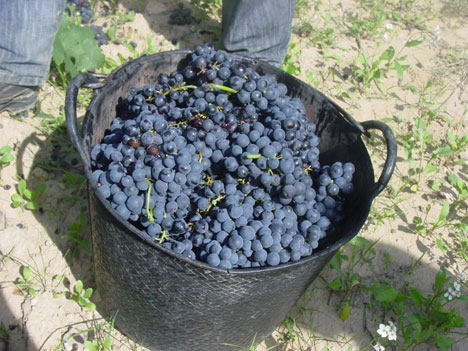 |
| The Tempranillo grape variety in Catalonia is called Ull de Llebre. (Photo: AVC) |
- Location: four non-contiguous subzones in the west of the region (province of Lleida): Artesa, Les Garrigues, Vall de Riucorb, Raimat
- Status: DO since 1988
- Vineyard area: 4,100 hectares
- Climate: continental, high solar radiation, low rainfall, strong temperature fluctuations
- Soil: predominantly calcareous and granitic with low clay content, poor in nutrients
- Grapevarieties white: Parellada, Xarel-Lo, Albariño, Sauvignon Blanc, Riesling
- Grapevarieties red: Cabernet Sauvignon, Garnacha Tinta, Monastrell, Pinot Noir, Samsó (Cariñena), Syrah, Trepat, Ull de Llebre (Tempranillo), Syrah
- Wines: White, rosé, red and sparkling wines
- Location: in the extreme northeast on the Mediterranean coast (province of Girona), divided into two separate subzones around the towns of Figueres and Parafrugell
- Status: DO since 1975
- Vineyard area: 2,300 hectares
- Climate: Mediterranean with cold
North winds
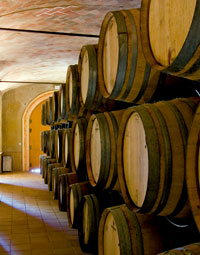 |
| Many Catalan wines mature in oak barrels. (Photo: AVC) |
- Soil: calcareous and nutrient-poor, in the mountains with granite, in the plains alluvial soil, on the coast also slate
- Grapevarieties white: Chenin Blanc, Macabeo, Muscat, Parellada, Riesling, Xarel-Lo, Chardonnay, Gewürztraminer
- Grapevarieties red: Cariñena, Cabernet Sauvignon, Syrah, Tempranillo
- Wines: mainly Rosados, but also Rancios, Mistelas and sparkling wines
- Location: in the south of the region, almost completely surrounding Priorat (Tarragona province)
- Status: DO since 2001
- Vineyard area: 2,000 hectares
- Climate: continental with Mediterranean influences, humid Mediterranean winds, small temperature differences between day and night
- Soil: calcareous with pebbles, granite sands, slate
- Grapevarieties white: Macabeo, Garnacha Blanca
- Grapevarieties red: Cariñena, Garnacha Tinta, Tempranillo
- Wines: White, rosé and red wines, as well as specialities such as oxidative barrel-aged and fortified wines (Vi Ranci) and Mistelas
- Location: around Vilafranca del Penedès on the Mediterranean coast (provinces of Tarragona and Barcelona), divided into three subzones ascending inland from the coast: Bajo-Penedès, Medio-Penedès, Alta-Penedès
- Status: DO since 1960
- Vineyard area: 26,500 hectares
- Climate: mainly Mediterranean with hot summers and mild winters, but different microclimates due to the altitudes
- Soil: chalky limestone, in the river valleys also alluvial soil
- White grape varieties: Parellada, Macabeo, Xarel-Lo, Moscatel de Alejandría, Chardonnay, Chenin Blanc, Sauvignon Blanc Gewürztraminer, Riesling
- Red grape varieties: Garnacha Tinta, Monastrell, Cariñena, Ull de Llebre (Tempranillo), Cabernet Sauvignon, Pinot Noir, Merlot
- Wines: Sparkling wines (about two thirds of the total Spanish cava production) as well as white wines and fortified sweet wines
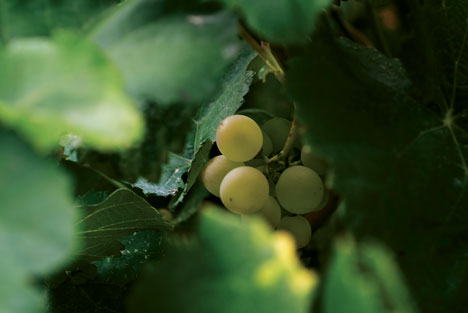 |
| White grapes often provide the base wines for Cava. (Photo: AVC) |
- Location: around Manresa in the centre of the region (Barcelona province)
- Status: DO since 1997
- Vineyard area: 50 hectares
- Climate: Mediterranean with warm summer nights, hot autumns and sufficient rainfall
- Soil: alluvial and calcareous with sand and clay components
- Grapevarieties white: Macabeo, Picapoll, Chardonnay
- Grapevarieties red: Garnacha, Sumoll, Tempranillo, Cabernet Sauvignon, Merlot
- Wines: mainly sparkling wine, white young wines (jovenes) and rosados
- Location: in the south of the region, almost completely surrounded by Montsant (Tarragona province)
- Status: DOCa since 2001, previously DO since 1954
- Vineyard area: 1,600 hectares
- Climate: Mediterranean, mild and dry
- Soil: volcanic, small-leaved slate (Llicorella)
- Grapevarieties white: Garnacha Blanca, Macabeo, Pedro Ximénez, Chenin Blanc
- Grapevarieties red: Garnacha Tinta, Carineña, Cabernet Sauvignon, Merlot, Syrah, Pinot Noir
- Wines: mainly concentrated, mineral, often high-alcohol red wines
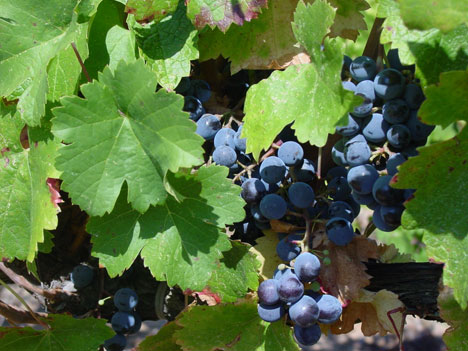 |
| Carineña is widespread in Priorat. (Photo: AVC) |
- Location: on the Mediterranean coast around the city of the same name (Tarragona province), divided into two separate subzones separated by Montsant and Priorat: El Camp, Ribera d'Ebre
- Status: DO since 1947
- Vineyard area: 7,300 hectares
- Climate: in the Ribera d' Ebre subzone strongly influenced by the Ebro and rather continental with hot summers and cold winters; in the El Camp subzone Mediterranean with smaller temperature differences between day and night
- Soil: calcareous, in the vicinity of the Ebro also alluvial soil
- Grapevarieties white: Chardonnay, Garnacha Blanca, Macabeo, Malvasía, Moscatel de Alejandría, Moscatel de Frontignan, Sauvignon Blanc, Xarel-Lo
- Red grape varieties: Cabernet Sauvignon, Garnacha, Merlot, Monastrell, Pinot Noir, Samsó (Cariñena), Syrah and Ull de Llebre (Tempranillo)
- Wines: mainly red wines as well as Mistelas and Rancios, also Cava base wines
- Location: in the extreme southwest of the region around Gandesa (Tarragona province)
- Status: DO since 1985
- Vineyard area: 8,300 hectares
- Climate: Mediterranean with continental influences, winds from the north (Cierzo) and southwest (Garbi), dry, hot summers, cold winters
- Soil: calcareous and clayey with gravel, low in nutrients
- Grapevarieties white: Garnacha Blanca, Macabeo (Viura), Moscatel, Parellada, Viognier, Caladoc, Marselane
- Grapevarieties red: Cabernet Sauvignon, Cariñena, Garnacha Tinta, Merlot, Morenillo, Syrah, Tempranillo, Petit Verdot
- Wines: White and red wines as well as Mistelas and Rancios, also Cava base wines
The bodegas and their wines
The following producers sent in wines for our current tasting:
All currently tasted red wines from Catalonia in the wine guide
All currently tasted white wines from Catalonia in the Wine Guide
All currently tasted Cavas in the Wine Guide
All Catalan producers in the wine guide
To the homepage of the Associacio Vinicola Catalana








